Apple's iPhone 4: Thoroughly Reviewed
by Brian Klug & Anand Lal Shimpi on June 30, 2010 4:06 AM EST- Posted in
- Smartphones
- Apple
- iPhone 4
- Gadgets
- Mobile
FaceTime
Meet Manveer. I’ve known him since I was in the 6th grade. Somewhere around the 8th grade we started a ritual of calling each other every day after school and talking about video games, computers and dumb things that happened at school. We talked on the phone for hours. Back in those days we would even play the same game on separate computers while talking on the phone. It was a precursor to voice chat in gaming networks like Steam or Xbox Live. It was ridiculous amounts of fun.
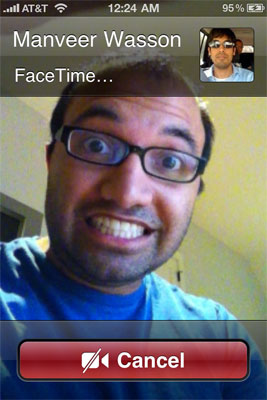
Manveer is up in the corner, the crazy guy is yours truly
Tonight Manveer and I FaceTimed. It’s the feature I wish we had when we were back in middle school. These days it’s a lot harder to explain why you’ve got some random dude’s face on your phone talking to you about completely pointless things at 12:54AM on a Tuesday night. I spent part of the chat covering one of the lights in my room with my head and calling it an Anand Head Eclipse. At the risk of further embarrassing myself publicly, it was fun.
For those of you who don’t know, FaceTime is Apple’s VoIP protocol built into the iPhone 4.
Granted we’ve been able to do this sort of thing for quite a while now over instant messenger networks. Integration into your smartphone is just the next logical step, and in the right conditions it works very well.
 |
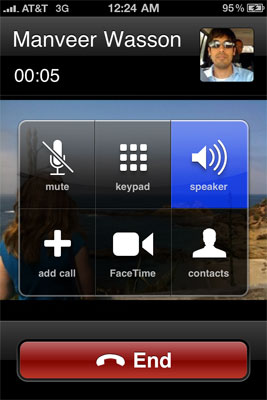 |
The first requirement is that both users need to have an iPhone 4 obviously. Both also need to be on WiFi. While the FaceTime icon will appear if you call another iPhone 4, if you try to activate the connection you’ll get this error unless you’re on WiFi:
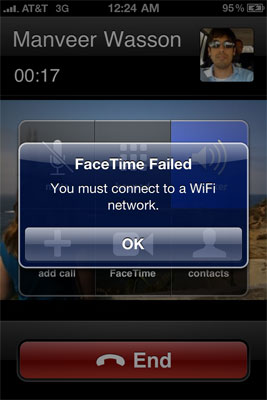
With a bit of poor UI design Apple will actually display a FaceTime icon with a question mark in it if you call another iOS phone. Trying to activate FaceTime however gives you an error.
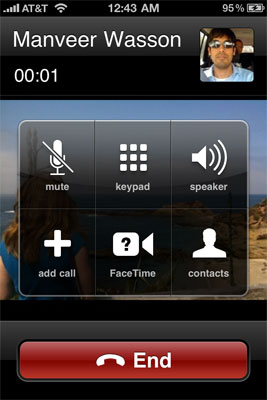 |
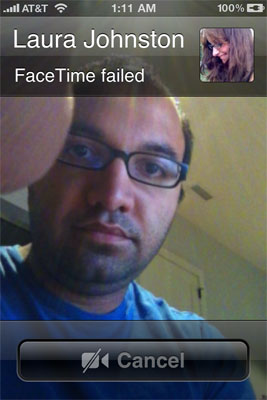 |
FaceTime requires roughly 100 - 150Kbps of bandwidth in both directions to work smoothly. The download should be fine but the upload is pretty high given that many broadband providers in the US are ridiculously stingy with their upload bandwidth. For FaceTime to work well you can’t be uploading or downloading anything large in the background, or if you are just throttle everything else to give you enough bandwidth to work with.
The next problem with FaceTime is the iPhone 4 lacks an absolutely necessary integrated stand. HTC got it perfect with the EVO 4G, unfortunately the 4 has no such thing. The closest you can get is Apple’s iPhone 4 dock, it’ll set you back $29 but it’s necessary to prevent you from getting tired holding your phone out in front of you. Laying the 4 down on your desk while you FaceTime just gives the person on the other end of the line a great view of your nostrils. Not very welcoming.
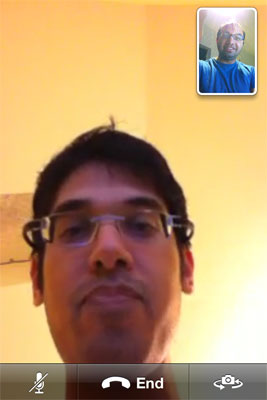
This is the on-table view of FaceTime, you need a stand
Even once you’ve met all of the requirements it’s still not a guaranteed thing. Even with ample bandwidth I had one FaceTime chat stall in the middle of the chat. My incoming feed froze and I had to wait a couple of seconds for it to resume. I also had a problem where FaceTime would fail to start on the first try. A subsequent try fixed it.
As you'll see in our camera investigation, the low light performance of the 4's front facing camera is horrid. Couple that with FaceTime and you will get bad image quality if you're not in a well lit room:

Ugh, what is this, 1998?
While in FaceTime you can easily switch between front and rear cameras by tapping the camera icon in the lower right corner. Unfortunately the compression on the video is enough to render text illegible while in FaceTime:
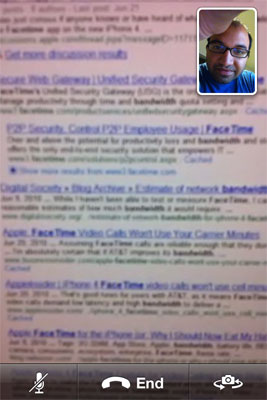
This was taken using the rear facing camera over FT
Obviously everyone knows where FaceTime is going. Apple is supposedly opening the protocol up to all developers, so you’d be able to theoretically build desktop and other smartphone FaceTime clients. And ultimately as mobile broadband speeds (hello WiMAX and LTE) improve the WiFi requirement will be dropped. But is it a good feature today?
It really depends on who you know with an iPhone 4. If you’ve got a Manveer, absolutely - the feature is worth it. If you have a bunch of casual acquaintances with iPhone 4s, probably not. It’s only useful if you know the person on the other side very well.
There is one other major benefit to FaceTime. Once enabled your call is routed over WiFi to the Internet, not AT&T’s 3G network. It doesn’t use any of your plan’s minutes and more importantly, voice quality is much improved over a regular 3G/EDGE phone call. It’s VoIP, not a crappy cell connection. Even if you just cover the camera it’s actually better to make calls over FaceTime than 3G based on the sound quality alone.










270 Comments
View All Comments
bplewis24 - Monday, July 12, 2010 - link
Consumer Reports confirms what I have commented on earlier about this article: that the "best case scenario" testing of one phone is clearly an attempt to excuse away this clear design flaw in a biased review. See the article here: http://blogs.consumerreports.org/electronics/2010/... .And watch the video. This testing was done in a controlled environment with an RF Isolation Chamber that is impervious to outside radio signals. I suggest you guys stop misleading the tech nerd population with this review now, and revise it.
Brandon
plastic_avatar - Monday, July 12, 2010 - link
How can you not respect the research of someone who slides in an apt geek reference?zholy - Tuesday, July 13, 2010 - link
Only Apple can release a product with such a design flaw and respond to complaints with either "you're holding it wrong" or "buy another product to make it work correctly". Any other company would have their product returned in droves, Mac fanatics just say "ok"Hengie2000 - Saturday, July 17, 2010 - link
Help! I am a wireless tech that uses field test daily to survey in building wireless projects, but the iphone 4 or 4.0 upgrade lost that capability. I am willing to pay for someone to make a field test app or follow the steps that Brian and Anand have listed in this story. Is there any way to reach these guys for more details to get field test running on the iphone4? Does this give full field test menus or only replaces the signal bars with decibels?Stang289 - Monday, July 26, 2010 - link
It would be great if you had Palm Pre Plus and Pixi Plus performance numbers included in smartphone reviews. I would like to see how they stack up against other smartphones.marxster - Thursday, September 9, 2010 - link
...after all that, I'll give you my real world experience. We have a 3Gs and a 4 in our household. The 3Gs always shows more bars and does not drop calls at all while my iPhone 4 does drop calls and has less bars.We live far away from the closest tower and the iphone 4 doesn't ever get better reception here than -103db.
I'm now afraid to receive calls because I know they'll be dropped. Makes my phone useless.
I should say that both phones are on the latest iOS version and there isn't much of a difference whether I use a case or not.
By the way, please explain this to me. Why did Apple bother to spend millions of dollars shipping out cases when they clearly don't get rid of the problem. When I cup my phone with the case on, the bars drop just the same as without.
MisterQED - Wednesday, October 20, 2010 - link
I am not a member of the “tin foil hat” crowd, I’m a guy with a physics degree and a Ham license, so I know a bit about radios. What I am about to point out seems so obvious to me, but I have never heard it discussed anywhere. Your article discusses the effects of having a exposed antenna as it effects phone reception, but that misses the main point, this is a receiving and transmitting antenna. Having skin contact with a transmitting antenna is not safe. Allow me to explain my thought process and tell me if I have a flaw in my logic.1) Constant irritation causes cancer. Whether it is fiberglass fibers, silica dust or coal dust in our lungs, to UV radiation from skin exposed to the sun, if you irritate an area consistently for long periods of time, you are just asking for cancer.
2) RF radiation from most phones is a subject of worry and present discussion, but it doesn’t worry me. RF radiation is a worry because it will cause electrical conduction thru body tissue. This would be an irritation and consistent irritation can lead to cancer. RF radiation from most phones has two methods of conduction, capacitive and inductive.
a) Capacitive needs: a sizable area, small dielectric distances and high frequencies. Cell phones have the high frequencies, but all other designs keep minimal gaps between antennas and the operator’s skin. Also the operator’s finger tips provide a rather small area to support capacitive conductance.
b) Inductive conduction needs frequency matched radiators to allow conduction i.e. a good antenna on each end. Body parts make poor antennas, and bodily dimensions generally don’t match the proportions of ideal radiators, so inductive conduction isn’t really a worry.
3) iPhone 4s, unlike any previous device, allow a third and a magnitude more effective connection between an operator and a transmitting antenna, a resistive connection. All a resistive connection needs is a low resistance, which skin has when sweaty or damp and the antenna has if it is not covered by a non-conductive coating. To add insult to injury, this contact de-tunes the antenna making it less efficient. This inefficiency causes the transmitter to up the power output as cell phones work on a “yell loud enough to be heard” system, so the worse the reception the more power the phone will pump into the antenna to be able to communicate with the cell tower.
So unless you can show me where my logic has lead me astray, I would expect that in the future some percentage of the population that use an iPhone without a case may find a small possibly cancerous mole forming on one of their fingertips.
That is a bigger problem than some dropped calls, so why didn’t you mention it.
smithpercy - Sunday, November 14, 2010 - link
Does this mean that I could cold weld a suitable socket to the gsm antenna side strip to allow a patch cable to an external antenna and get reception in the very marginal areas that I spend most of my time in?? I know that the shield would have to be grounded but that could be done thru one of the other connectors. I understand that would void the warranty, and give apple a conniption fit but that is their problem.keri - Thursday, February 24, 2011 - link
serious question here.jessicacoles - Saturday, December 12, 2020 - link
https://reviewsicon.com/